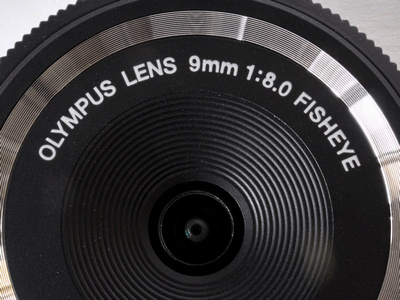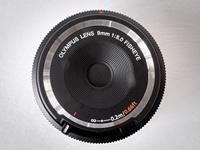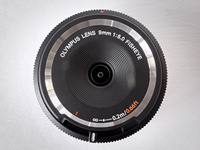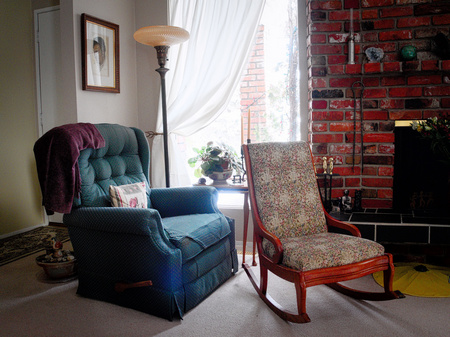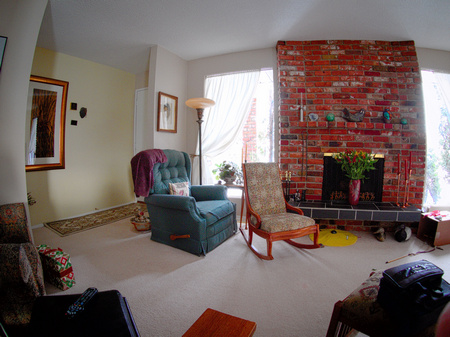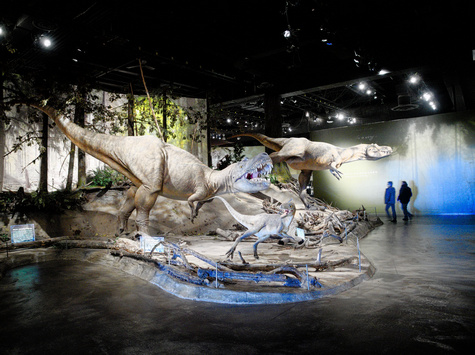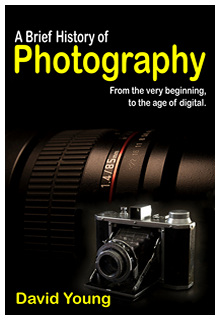The 9mm/f8 Olympus "Fisheye": (Tested on the E-M1 with firmware v 1.4.) It never occurred to me, to even consider the purchase of Olympus' original body cap lens ... the 15mm f8. After all, I already had the 12~40/2.8 m.Zuiko, so why would I want a 15mm? True, it weighs next to nothing, and is only 9mm thick ... but for the limitations, I just couldn't see it ... at least, not for my own use. But the 9mm Fisheye? Now that's a different kettle of fish! First of all, it's considerably wider than the short end of my 12~40 zoom, and while the fisheye perspective is only really suited to specialized views of the world, what it does, it does very well... and costs next to nothing, to have it in your bag!
to infinity falls within the
depth of field." (John Shaw's Landscape
Photography, John Shaw, 1994)
This is the position where depth of field will cover any difference in focus from infinity down to (in the case of the 9mm Fisheye) around a meter or so. Thus, this is where you'll leave it, for most shots. Finally, the rightmost position is for close-ups, and it will focus down to 8" (or 0.2 meter, if you prefer). However, here, focus is quite critical and you may want to measure... or at least use the EVF magnification or focus peaking, while you move the camera back & forth, to achieve the best focus. After all, even at f8, Depth of Field becomes quite shallow at very close distances. These postions are shown in the four images below. (You can click on each of the 4 images , for a bigger view. Use your browser's BACK button to return to this page.)
I was heading on holiday, the day after I received the lens, so my
first chance to use it was in a friend's living room.
Sitting in one of his chairs, I shot the room at 16mm, with my 12~40/2.8 Zuiko zoom. I then swapped lenses, and set the 9mm to the hyperfocal distance, and fired away. The true "fisheye" perspective is readily seen in the right hand shot!
If
you look carefully, in the
bottom right corner of the fisheye version, you can just see my finger!
At 140 degrees coverage, just holding the E-M1, with it's decent sized grip, puts your right fingers at risk of being in almost every shot ... so you have to pay attention! This next series of images were taken in the Royal Tyrrell Museum of Paleontology ... one of the largest and finest dinosaur museums in the world - located in Drumheller, Alberta, Canada. The shot on the left was made with my back to the wall, and the 12~40/2.8 set as wide as possible, in order to "get it all in". For the shot on the right, I moved up to within 1 meter of the face of the frontmost dinosaur and with the focus set to the hyperfocal distance, fired away. The difference in viewpoint made possible by the 9mm lens is dramatic!
Like
many, if not most, museums, monopods and tripods are forbidden. (Well, you can use
them, if you arrange it well in advance and pay a substantial "professional use" fee.) So, the superb, 5 axis In-body-Image-Stabilzation of the E-M1 came in very handy. Exposures were 1/10th of a second for the wide shot, and 1/3 of a second for the close-up, on the right. As for effectiveness of the two, well, there is no comparison! You can also use the manual "fisheye" slider in PT-lens (an excellent, low cost, automatic, lens distortion correction tool) to remove the "fisheye" look, when it is apparent in shots. This allows you to have an 18mm equivalent, rectilinear lens for just $99! See the natural (fisheye) shot of a hotel room, on the left, and the corrected version, on the right. Depending on the angle of the shot, this "cure" does not always work, but in my experience it works more often than not. 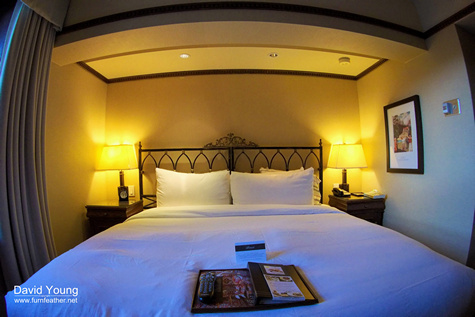 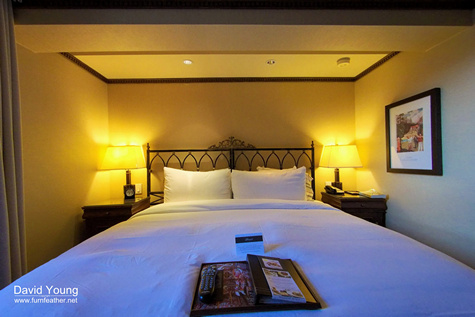
So that's about it. An inexpensive lens that offers a lot
more
quality, detail & sharpness - not to mention, FUN, than you'd ever think possible, for just $99. A fisheye lens is one that most people would rarely want to use, but when you're back's to the wall, and you simply need to "get it all in", then the Olympus 9mm Fisheye-in-a-body-cap will save your bacon. And it will do it without straining your back or your budget! Best "bang for the buck" I've seen in many a year!
|
||||||||||||||||||||||||
